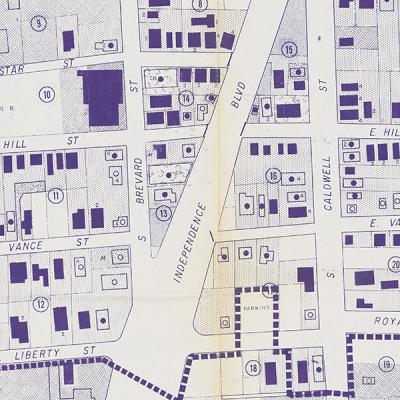A project spearheaded by Johnson C. Smith University (JCSU) aims to create a virtual reconstruction of Charlotte’s African American neighborhoods before the displacement brought by “urban renewal” projects in the 1960s and 1970s. Special Collections & University Archives (SCUA) staff are collaborating by providing digitization services and historical research for the multi-year project funded by the Knight Foundation, the National Park Service, and the National Historical Publications and Records Commission.
The Brooklyn neighborhood in Charlotte’s Second Ward was a thriving African American community prior to the 1960s, when the Charlotte Redevelopment Commission razed it in several stages to make way for Government Plaza buildings along with several other structures and thoroughfares. The JCSU project strives to connect the past with the present, working with Duke University’s Digital Humanities Lab to incorporate digitized images into an augmented reality website designed to recreate the landscape of Brooklyn and other Black neighborhoods.
SCUA is supporting these efforts by digitizing larger format maps, ranging in size from 30-48 inches on the longest edge. (Some are so large they must be stitched together from two or more captures). Created by the Charlotte Redevelopment Commission, they show the disproportionate impact of urban renewal on Charlotte’s Black neighborhoods, Brooklyn in particular. They document the terrain of Charlotte’s primary “urban renewal” zones prior to redevelopment and delineate planned changes to the areas. Some will help pinpoint the locations of businesses and homes that were destroyed.
SCUA is also collaborating on research for the project, referencing several collections that are held here. Among these is the Charlotte Redevelopment Commission records, which contains images of houses, businesses, and residents in the Brooklyn community. In addition, SCUA holds oral history interviews of Brooklyn residents that were conducted as part of a graduate class project directed by Associate Professor of History Karen Flint in 2007. These records and others provide a rare opportunity to contextualize a historical event from both sides of the fence.
--Adreonna Bennett, Rita Johnston, and Stacy Rue
Image: Detail of map of the Brooklyn Section 5 Project Area, 1966 (revised 1970).
